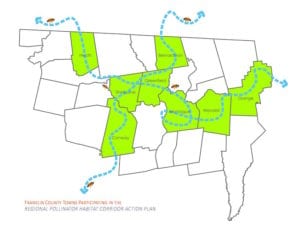Who is a member?
Our members are the local governments of Massachusetts and their elected and appointed leadership.

Eight Franklin County towns have joined forces to protect pollinators.
Eight Franklin County towns are participating in a new program to protect native pollinators, which are threatened by habitat loss, invasive species, pesticides, disease and parasites.
With funding from a state planning grant and the District Local Technical Assistance program, the Franklin Regional Council of Governments will work with Bernardston, Conway, Greenfield, Heath, Montague, Orange, Shelburne and Wendell to map the habitat and resource areas of local pollinators and identify corridor linkages.
The Regional Pollinator Habitat Corridor Action Plan will also update local land-use regulations to include requirements for native plantings and pollinator-friendly landscape management practices, and create Pollinator Habitat Corridor Implementation Toolkits unique to each town.
“The community-centered process that Franklin Regional COG has embraced throughout this project has been critical,” said John Lepore, a sustainable landscape designer and Planning Board member in Bernardston. “There is a pretty high level of interest in Bernardston regarding looking at pollinator habitat and how we can do a better job supporting the pollinators in our community. We’re very excited about the possibilities and the importance of this.”
Officials hope the regional pollinator plan, the first project of its kind in Massachusetts, will have an impact on land-use regulations across the county.
“If a community is going to be putting in rain gardens or bioretention areas or vegetated swales for a stormwater management project, that’s an opportunity to make sure you’re putting in plantings that support native pollinators,” said Kimberly Noake MacPhee, Land Use and Natural Resources Planning Program Manager for the Franklin Regional COG.
Native pollinators, including an estimated 380 species of bees and 120 species of butterflies, are considered keystone species because of their importance in maintaining healthy ecosystems. Without native pollinators, many native plant species are unable to reproduce. Pollinators are also essential to the health of the state’s food-production systems.
“When you think about climate resiliency, pollinators are so important to our ‘green infrastructure’ – our undeveloped areas, our woodland areas and grass areas, all of these areas that clean our drinking water, clean our air and absorb stormwater,” said Noake McPhee. “If you lose your native plants because you’ve lost pollinators, then your landscape is going to be more susceptible to climate change.”
The Regional Pollinator Habitat Corridor Action Plan seeks to increase and map pollinator habitat as well as interconnected areas of habitat.
With these habitat maps in hand, local planning boards and conservation commissions “can find gaps in pollinator habitat in their community and find opportunities where new projects could help build and maintain native pollinator habitat,” said Noake McPhee.
The project also intends to increase awareness about the life cycle needs of pollinators and provide detailed planting guides for each town. This is a part of the project that is especially exciting for Bernardston. “Changing people’s thinking about what native planting does for the food chain is going to be a big part of this project,” said Lepore.
Bernardston hopes to take a community-centered approach while challenging residents to plant native species and use pollinator friendly land management practices, including cutting down on herbicide and pesticide use. “I think the most important part is community engagement and education,” said Lepore.
The Franklin Regional COG also hopes the Regional Pollinator Habitat Corridor Action Plan can serve as a jumping-off point for other communities. “When other communities look at what we will produce, they will probably be most interested in our suggested updates to the land use regulations, such as how can they make subdivisions, redevelopment projects, and new developments more pollinator friendly,” said Noake McPhee.
The planting lists, best management practices, and mapping methodology could be used as models in communities and regions across the state, she said.
“The opportunities are unbelievable,” she said. “There are so many ways that habitat can be created, and it doesn’t require a lot of change in the way we are already doing things. It’s something as simple as including native perennials that support pollinators in a normal garden or park planting.”
For more information, contact Kimberly Noake McPhee at kmacphee@frcog.org.
Written by Elisa Sturkie